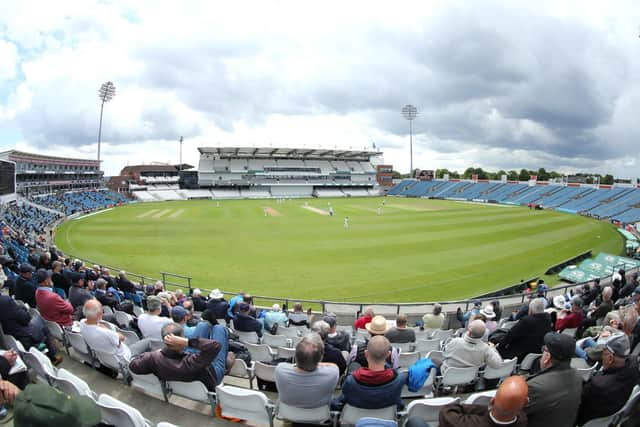Chris Waters - Why it is time to stop tinkering with our traditions


Consider what we know so far.
Under plans presently being discussed and favoured by the first-class counties, including Yorkshire, the 18 teams are set to be split into three conferences of six along the lines of this year’s Bob Willis Trophy.
That competition worked well as a temporary solution to you know what, which effectively wiped out two-thirds of the season, and was played along regional lines to cut down on travelling and to prevent the spread of you know what.


Advertisement
Hide AdAdvertisement
Hide AdThe Conference system would do away with those regions (a good thing) and replace it with a method based on finishing positions in the 2019 County Championship, which would involve a strange sort of zig-zagging across the existing two divisions to work out the composition of each conference (perhaps not such a good thing).
Ergo, if you imagined the existing two divisions as one long division, teams one, four, seven, 10, 13 and 16 in the 2019 table would form Conference One; teams two, five, eight, 11, 14 and 17 would form Conference Two; and teams three, six, nine, 12, 15 and 18 would form Conference Three.
The idea is to equalise, as far as possible, the standard in each Conference and would see next year’s Conferences look like this:
Conference One: Essex, Kent, Warwickshire, Northamptonshire, Durham, Middlesex.


Advertisement
Hide AdAdvertisement
Hide AdConference Two: Somerset, Yorkshire, Nottinghamshire, Gloucestershire, Sussex, Worcestershire.
Conference Three: Hampshire, Surrey, Lancashire, Glamorgan, Derbyshire, Leicestershire.
Although Yorkshire’s group looks decent for mileage purposes re my expense claims, by far the most important consideration, this seems a curious way to me of trying to decide the best team in the country.
Under this system, each side would play 10 games (five home, five away) in the first half of the summer before the break for white-ball cricket and the competition that I know that most of you, like me, simply can’t wait for: The Hundred.
Advertisement
Hide AdAdvertisement
Hide AdThe counties would then be split into three new divisions for the last two months of the Championship season, with the first and second-placed sides from each Conference going into Division One, the third and fourth-placed teams into Division Two, and the fifth and sixth-placed sides into Division Three.
Clubs would then play a further four games (two home, two away – avoiding their opponents in the Conference stage), with the top-two from Division One set to contest a five-day final.
Should this system be adopted permanently (it is expected to be introduced next summer on a trial basis), then each year’s finishing positions would determine the following year’s Conferences.
Okay. Fair enough. It could be argued that this is a more interesting way of arranging the teams and keeping things fresh, but the overarching complexity – hardly likely to convert the heathen – is far from my only gripe.
Advertisement
Hide AdAdvertisement
Hide AdFor what is the raison d’etre of this policy? What is it designed to do and presumably to fix? Its proponents, including Yorkshire, believe that there are myriad benefits: ie, by doing away with promotion and relegation, teams may be more inclined to give youngsters an opportunity and less inclined to make short-term signings; that each county will have a chance of winning the competition each year, and that smaller counties may be more likely to retain a first-class future; and that it would do away with the somewhat hopeless feel to the bottom end of Division Two, where the likes of Leicestershire are usually to be found trying – and mostly failing – to hitch up their trousers.
They argue that plans for a so-called ‘Super September’ and ‘Race to Lord’s’ to round off this cricketing panacea would inject vibrancy into the county game, and that the paying of prize money down to 14th place would do away with ‘dead’ matches towards the end of the summer.
Okey-dokey, I get all that. There are potential benefits on paper, but I wonder whether they would exist in reality?
For example, coaches will surely still be expected to win and to get results – otherwise, they are more likely to find themselves driving coaches for a living.
Advertisement
Hide AdAdvertisement
Hide AdThe Yorkshire members, for example, delighted though they have been to see a number of young players come through this summer, will not be so delighted if that is not backed up by results on the field.
There exists the potential for all counties, does there not, of the all-too easy excuse: “Yes, we know we finished halfway down Conference Three again, but look at the three 19-year-old batsmen that we gave debuts to in July.”
Rather than drive up standards, and therefore help to keep England competitive at Test level, which you’ll notice they are at present, it is more likely to reduce those standards if there is not that threat of relegation and the carrot of promotion, along with sensible overseas signings who can help to challenge young English talent.
Furthermore, the big and small clubs will still be the big and small clubs; Headingley will always be a more attractive destination for a budding Test player, say, than Grace Road.
Advertisement
Hide AdAdvertisement
Hide AdOld cynic that I am, I can’t help but feel that the abolition of relegation is the prevailing motive for the bigger counties, who would be freed from that pressure and the consequences of it.
Coaches always face a tough balancing act in trying to win in the present while developing for the future, and Yorkshire have done it as well as any club in recent times.
All the more laudable, in my eyes, that they have done it within the two-division structure, the only problems with which, as far as I can see, is that the number of games has come down from 16 per county to 14, and that the divisions have become unbalanced with sides not necessarily playing each other home and away.
In an ideal world there would be just one division, as there always used to be before white-ball cricket ruled the roost. I have even seen it suggested that this could be facilitated by clubs running separate red and white-ball teams.
Advertisement
Hide AdAdvertisement
Hide AdWhatever your view, on this we surely can agree: the Championship doesn’t need all this endless tinkering.
It just needs the sort of love and support that the Yorkshire members, in particular, have always given it, and a governing body that listens to them.
Support The Yorkshire Post and become a subscriber today.
Your subscription will help us to continue to bring quality news to the people of Yorkshire. In return, you’ll see fewer ads on site, get free access to our app and receive exclusive members-only offers.
So, please - if you can - pay for our work. Just £5 per month is the starting point. If you think that which we are trying to achieve is worth more, you can pay us what you think we are worth. By doing so, you will be investing in something that is becoming increasingly rare. Independent journalism that cares less about right and left and more about right and wrong. Journalism you can trust.
Thank you
James Mitchinson
Comment Guidelines
National World encourages reader discussion on our stories. User feedback, insights and back-and-forth exchanges add a rich layer of context to reporting. Please review our Community Guidelines before commenting.